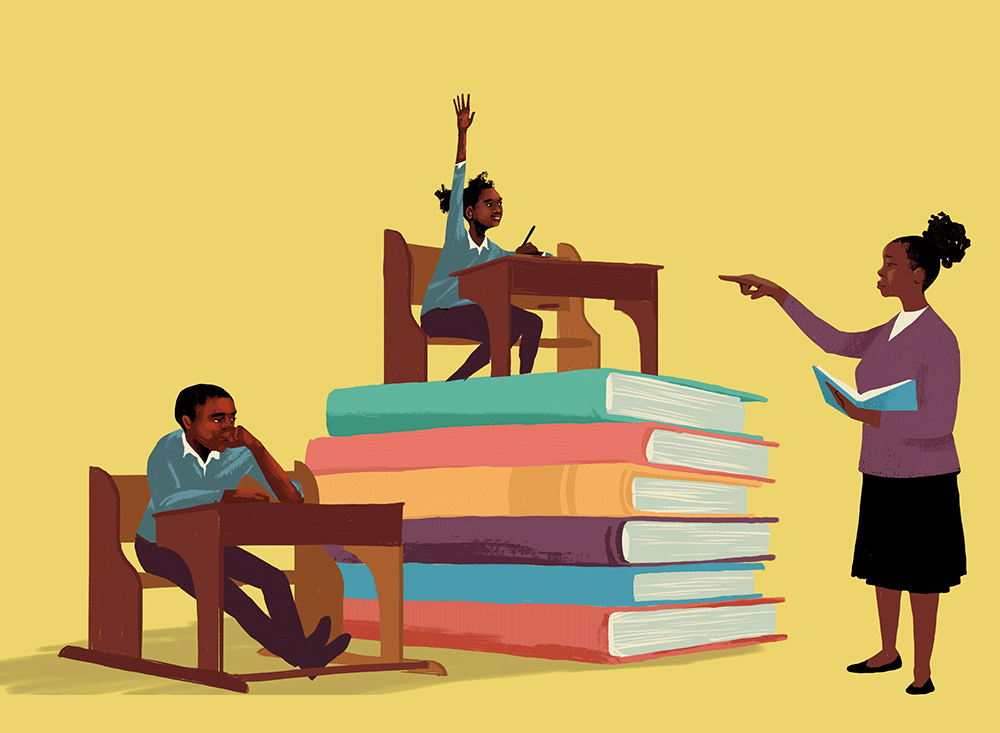Early on in her career, Rebecca Rhodes, a former teacher, spent several years working in Mali to improve primary education and literacy. Her team taught in French, because that’s the official language in Mali, but they quickly concluded the children weren’t learning.
One reason? There are 80 different languages spoken in Mali, and most of her students did not speak French at home. Rhodes and her team made rapid adjustments, including mapping and teaching in different languages.
Years later, Rhodes concedes that language of instruction is still important, but it’s just one piece in a complicated puzzle for improving literacy.
“It’s an important piece, but it is only one element in strengthening an education system to ensure children and youth are in school and learning,” said Rhodes, who now serves as a team lead for reading and literacy programming at USAID.
Although there are more children in classrooms today than there were 15 years ago, many are still not learning and progressing. Moreover, 262 million children in primary school are not learning to read. This is particularly troubling because literacy is a skill that is foundational to acquiring more advanced skills, and has a direct correlation with a person’s future earnings and employment.
Books are another important piece in the literacy puzzle—and many schools in low- and middle-income countries do not have the books they need.
Though many have tried to address the lack of books in schools, USAID along with other donors and partners agreed that a more transformative approach was needed—one that addressed the whole system with a coalition of actors.
“The idea of a global approach to providing books was really a new idea,” said Rhodes. “We knew that assembling pooled funding in a sector like health had worked. But we didn’t know if we could do the same to get the right books to the children that needed them.”
USAID asked Results for Development (R4D) to conduct a study to see what was possible.
The resulting feasibility study—completed by R4D and International Education Partners—looked at whether a global response and a global financial resource would make a difference.
Why books?
In recent years, global education experts have warned of the global learning crisis, which costs governments $129 billion annually and threatens to undermine the most fundamental development goal: ending extreme poverty. The 2017 Global Education Monitoring Report estimates that 37 countries in particular are losing at least half the funding they spend on primary education because children aren’t learning the basics in reading, writing, and math.
Numerous studies show that textbooks are one of the most cost-effective inputs for improving learning outcomes. And while evidence on story books is limited, experts agree they are particularly important in building foundational literacy skills and may be more effective than textbooks in early grade learning.
However, despite the clear evidence that books are vital to learning, a massive book gap exists.
A study in Cameroon showed children taught in their local language, Kom, had a marked advantage in achievement in reading and comprehension compared with children taught only in English. Kom-educated children also scored twice as high on math tests at the end of grade 3.
Rhodes is passionate about addressing this issue. “We can’t move forward in education without being sure that every child has the books that he or she needs,” she said. “And if we can’t move forward in education, then we certainly can’t grow economic opportunity or help people or countries on the path to self-reliance or be good stewards of the taxpayer dollar.”
Making the case for a global coalition
Between 2015 and 2016, R4D and IEPartners worked to understand why there are so few books in local languages in developing countries and whether a new global entity could help fix this problem.
The study included in-depth research of 13 countries to explore the availability of reading books for primary grades. It also took a market shaping approach—looking holistically at the demand, supply, and financing aspects of local language books to identify market and delivery barriers. The analysis also covered demand channels and usage, procurement, distribution, publishing, printing, and financing.
Results for Development found a combination of factors contributing to gaps in availability of reading books in local languages, among them:
Procurement of reading books for schools is fragmented, inefficient, and/or non-existent.
Where reading books are available in classrooms, they are often not used. This reflects a general lack of awareness among government officials, parents, and teachers about the value of reading books in supporting literacy.
There is a shortage of reading book content in local languages, with very few incentives to address the shortage.
Costs related to making local-language reading books available in classrooms are high.
Government budgets allocated to reading books are inadequate.
When budgets are earmarked for reading books, they are inefficiently deployed.
Rhodes said one of the biggest themes from the study was the application of the market shaping approach for books.
“The study highlighted that you could look at the different steps in the book chain (from conception to use) and say, OK, in each area of this chain—in each link—there are levers to incentivize or disincentivize certain behaviors and certain efficiencies.”
She added, “Working with market shaping on the book chain is probably in the top three of innovative things that are happening globally in the education sector right now. And R4D’s work on this study led us in that direction.”
R4D also analyzed global health funds like the Global Fund to Fight AIDS, Tuberculosis, and Malaria; Gavi, the Vaccine Alliance; and the Global Financing Facility to see if these models could be applied to the book market—but recommended against a cookie-cutter attempt to replicate any of these mechanisms. However, it found that useful lessons—positive and negative—could be drawn from these health financiers, particularly the need for a new entity to leverage and coordinate existing efforts to transform the availability and usage of local language reading books.
Based on these findings, it was clear a new global mechanism was needed to more holistically address market problems in the entire book chain—from development to use—in a way that traditional project-based approaches couldn’t.
With the feasibility study, we learned that tinkering through a one-off program doesn’t work. It won’t ever be the systemic solution that is needed. There has to be a global approach to solve the book crisis.” — Rebecca Rhodes, USAID
Emergence of the Global Book Alliance
Building on the recommendations and findings from R4D’s feasibility study, the Global Book Alliance was formally launched as a partnership in December 2016, with USAID, the Norwegian Agency for Development Cooperation (Norad), the U.K. Department for International Development (DFID) and the World Bank.
Our raison d’être intervention is ensuring that every child is learning how to read effectively,” said Joseph Nhan-O’Reilly, who serves as chair of the Alliance and was part of the initial discussions on whether this kind of global mechanism could work. “We know that in order to do that they need access to high-quality reading material to spark a love of reading, which is fundamental to learning how to read.”
The mission of the Alliance is “to guarantee that children everywhere have the books and learning materials they need to learn to read and read to learn.”
They intend to do this by sharing best practices and focusing on three flagship initiatives (focused on supply side issues of the market) to help close the book gap, beginning with the Global Digital Library, which was launched in Addis Ababa, Ethiopia, earlier this year.
The Global Digital Library, led by Norad, aims to collect existing high-quality, openly-sourced early grade reading resources, and make them available online, mobile and for print. It will also facilitate translation and localization of these resources to more than 300 languages. Other types of learning resources may be included at a later stage.
In the coming years, the Alliance expects to launch two other flagships, Publishing Collaboratives and the Global Book Campaign, to increase the number and quality of locally developed books. The Alliance also plans to carefully evaluate the impact of its activities and test different approaches.
Members of the Alliance are taking a systemic approach to closing the book gap by looking at all points of the book chain. They also recognize the availability of books does not translate into appropriate use inside and outside of the classroom. Therefore, ensuring that teachers, families, and communities have the tools they need to use books to promote learning is a key priority.
Mark Roland, R4D’s program director for education, has watched with pride as the Global Book Alliance took shape.
“It’s been gratifying to see our team’s analysis and recommendations inform the creation of a new global effort to get books into the hands of children,” he said. “These kinds of partnerships and global collaborations are vital to accelerating long-term, sustainable improvements in literacy and learning.”
Though the Global Book Alliance has many projects underway, Nhan-O’Reilly said the Alliance is still working to refine its approach and, at a very basic level, get more people to understand the challenge and how a coordinated effort can help.
“We’re in a sense trying to build a shared understanding of the problem and of the possible solutions to it without necessarily pointing to one definitive way that the global book gap could be closed.”
ILLUSTRATIONS © RESULTS FOR DEVELOPMENT/NOAH MACMILLAN


